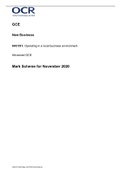Samenvatting
Summary The Psychology of Influence Pligt & Vliek- The Psychology of Media and Communication (6464EC03Y_2324_S1)
- Vak
- Instelling
- Boek
This is a summary of the book The Psychology of Influence by van der Pligt and Vliek for the course Psychology of Media and Communication. It includes all the chapters from the book. My grade for the course was an 9,7 :)
[Meer zien]













